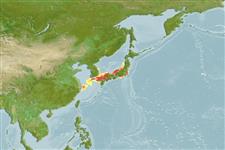Environment: milieu / climate zone / depth range / distribution range
Ecología
marino demersal. Temperate
Distribución
Países | Áreas FAO | Ecosistemas | Ocurrencias, apariciones | Point map | Introducciones | Faunafri
Northwest Pacific: Japan Sea off coast of northern Honshu, Japan.
Tamaño / Peso / Age
Maturity: Lm ? range ? - ? cm
Short description
Claves de identificación | Morfología | Morfometría
Espinas dorsales (total) : 11 - 13; Radios blandos dorsales (total) : 9 - 10; Espinas anales: 0; Radios blandos anales: 17 - 20. Closely resembles O. iburia in general appearance, but differs by having a few enlarged subpectoral plates, and 35 or fewer dorsolateral and ventrolateral plates.
Life cycle and mating behavior
Maturities | Reproducción | Spawnings | Egg(s) | Fecundities | Larva
Masuda, H., K. Amaoka, C. Araga, T. Uyeno and T. Yoshino, 1984. The fishes of the Japanese Archipelago. Vol. 1. Tokai University Press, Tokyo, Japan. 437 p. (text). (Ref. 559)
IUCN Red List Status (Ref. 130435)
Threat to humans
Harmless
Human uses
Herramientas
Special reports
Download XML
Fuentes de Internet
Estimates based on models
Phylogenetic diversity index (Ref.
82804): PD
50 = 0.5625 [Uniqueness, from 0.5 = low to 2.0 = high].
Bayesian length-weight: a=0.00389 (0.00180 - 0.00842), b=3.12 (2.94 - 3.30), in cm total length, based on all LWR estimates for this body shape (Ref.
93245).
Nivel trófico (Ref.
69278): 3.2 ±0.3 se; based on size and trophs of closest relatives
Resiliencia (Ref.
120179): Medio, población duplicada en un tiempo mínimo de 1.4-4.4 años (Preliminary K or Fecundity.).
Fishing Vulnerability (Ref.
59153): Low vulnerability (16 of 100).
